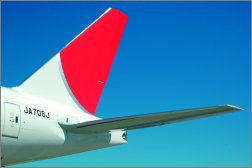The executive team of Japan Airlines (JAL) has been shown the door amid a revolt against their leadership of the increasingly troubled carrier as it issues yet another restructuring plan.
|
Shinmachi will formally step down in June, when he will become chairman, and he will be replaced by Haruka Nishimatsu, a 58-year-old company veteran. Nishimatsu is JAL’s senior vice-president finance and purchasing. His career has been almost entirely in finance roles and he has little top-level management experience.
Also resigning will be executive vice-president Katsuo Haneda, senior managing director Hidekazu Nishizuka and managing director Takenori Matsumoto, in addition to several other board members.
JAL, easily Asia’s largest airline group, has been struggling over the past year as its financial position has been deteriorating, in part because of increased fuel costs. It has also been hurt by a series of much-publicised safety issues that have prompted many Japanese travellers to switch their business to rival All Nippon Airways (ANA).
Internal calls for Shinmachi to step down had been growing for weeks, after four directors met him and asked him to quit to take responsibility for increased losses and the continuing effects of safety-related issues. Those directors had collected signatures from several dozen department heads to back their request, but Shinmachi refused to step down and publicly lashed out at them. However, the calls continued in the weeks following that confrontation, ultimately leading to hundreds of middle managers joining in the call for Shinmachi’s resignation.
Analysts say morale at JAL has been low and the unusually public nature of its internal troubles shows just how factional the group has become, particularly after the takeover of Japan’s number-three carrier Japan Air System. Shinmachi’s supporters have been progressively losing out to those who were never happy about him becoming chief executive, say many.
Shinmachi became chief executive only last April after long-serving chief Isao Kaneko stepped down, in part to take responsibility for the safety-related issues, which had resulted in an unprecedented “business improvement order” from the Japanese government. Many were hoping that the change in top management to Shinmachi would improve JAL’s public image. But it was not to be, as the new management was blocked in many of its attempts to seek support for badly needed cost-cutting measures.
“Resolution of the internal battle over director positions since mid-February with changes in top management, including the president, is a positive factor for implementing cost reduction measures,” says Tokyo-based BNP Paribas senior credit analyst Yasuhiro Matsumoto, adding that the management changes should be “positive for bringing internal rivalries under control”.
However, Matsumoto also says: “It is unclear whether the reforms will succeed at this point since management still needs to negotiate wage cuts with the union. JAL might have trouble reaching its goals for demand growth too, given the current situation in which business is shifting to ANA.”
Just a day after Shinmachi announced he was resigning, JAL unveiled a five-year restructuring plan aimed at returning the group to consistent profitability, largely through stepped-up cost-cutting efforts. It needs to get the restructuring right this time as the Japanese market is due to change dramatically in 2009 after a new runway opens at congested Tokyo Haneda airport, increasing slots by more than 40% and allowing new competitors to start challenging it. The Tokyo Narita international facility is also due to complete an expansion of its second runway that year.
JAL says its goal now is to achieve ¥119 billion ($1 billion) in annual cost savings by March 2011. It expects to return to profitability in the year to March 2007, while a further year on it should complete the “rebuilding of the business foundation”, enabling it to produce consistent profits despite outside influences. By March 2010 it expects to be producing “consolidated operating profit margins of 5% or more”.
Most of JAL’s losses are from international passenger operations and the carrier says its restructuring will focus heavily on cleaning up this part of the business, by dropping more money-losing routes, stepping up the retirement of older aircraft and using smaller aircraft on many services. It is also hoping that, with the management changes, employees will finally agree to pay cuts of around 10%, which the carrier was hoping to have implemented at the beginning of this year, but held back because of opposition.
The carrier also says that “safety and customer satisfaction will be at the forefront of the JAL Group’s medium-term business plan” and it will be investing around ¥60 billion in the years ahead “mainly to strengthen the maintenance foundation and improve operational quality”.
Another ¥65 billion will be spent “to enhance the quality of products and services and maintain our systems infrastructure, as well as to bolster our capability to handle unexpected operational events – delays and so on”.
JAL has also admitted to having a corporate structure that is too complicated, and under previously announced plans will merge main operating units JAL International and JAL Domestic in October this year. It says this will represent a key part of the “revival of the JAL Group in fiscal year 2006”.
There are still many who believe the airline is not moving fast enough to implement change, however. And while these observers say they will give the new management a chance, they warn that new chief executive Nishimatsu will need to show results quickly if he is to avoid the same fate as Shinmachi. ■
NICHOLAS IONIDES / SINGAPORE
Source: Airline Business




















